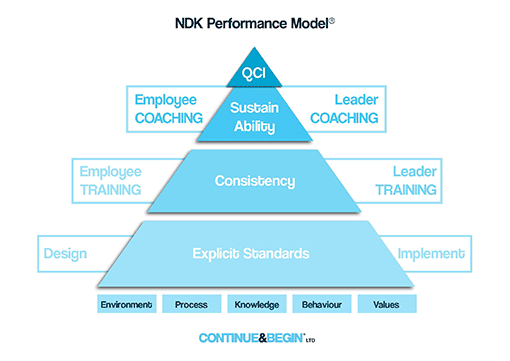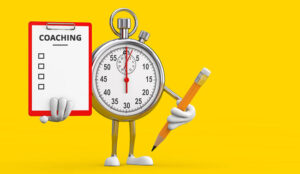Every coaching session comes at a cost! You are taking up an agent’s time, a coach’s time, and even making customers wait longer by taking someone away from the phones.
So how do you make sure it’s time well spent?
To find out, our Editor – Megan Jones – spoke to industry experts Brittany Hodak, Dan Pratt, Kim Ellis, Michel Stevens, Nick Drake-Knight, and Sandra Thompson for their best tips and advice on making every coaching session count!
10 Ways to Make the Best Use of Coaching Time
1. Never Start a Coaching Session by Letting Agents Think They Might Be in Trouble
Really think about HOW you invite agents to a coaching session – as things can get off to a false start if agents enter the meeting thinking that they are in trouble.

“When a manager comes over and says, “Can you finish that call and then join me over there?”, it can put an agent on high alert. They can even feel like everyone’s looking at them as they are marched into a meeting room… Only for it to turn out to be ‘just a quick coaching session’!
It’s far better to frame the conversation in a more casual and positive way. For example, “Finish that call, grab a cup of tea, and let’s go for a chat.”
It’s a small change that can make a big difference and save time too, as you won’t have to spend the first few minutes of every session reassuring the agent they aren’t in trouble – before continuing as planned.” – Kim Ellis, Chief Learning Architect at Go Ginger Learning Solutions
Note, wider company culture also has a part to play in this energy-draining sense of dread – particularly if all you’re doing is taking agents off the phones to “bash them over the head with their C-SAT scores”, so to speak.
2. Be Curious About Why an Agent Made the Choices That They Did
You really want your coaching sessions to be as positive as possible. One way to do this is to take more of an inquisitive approach – rather than jumping to conclusions.

“If you repeatedly tell someone, “Don’t do that,” or “Don’t do this,” they’re not going to know why. And if they don’t know why, it won’t log in their amygdala, which is the emotional part of the brain, and so the unconscious state will never make it a new habit.
However, when someone thinks for themselves, they are more likely to take corrective action because they’ll think through how they arrived at the answer.
To use this approach in your next coaching session, try saying “I’m curious to understand why you took the decision to say that…” or “Help me get to grips with the approach that you took…”. This way, you’ll find out more about their intentions and let them take the lead on a more positive conversation.” – Sandra Thompson, The Ei Evolution
3. Run Regular Surveys to Ask, “Was That Fun or Boring?”
A good way to double-check you are making the best of every coaching session is to survey your agents on how they found it – in the same way you’d survey customers.

“Always ask your agents what they thought of a coaching session – including “What did you find fun?” and “What did you find boring?”
Because if you can capture honest feedback that people were just zoning out for the PowerPoint presentation, but really engaging with the sticky notes exercise (for example) you can evolve your sessions to make them more engaging in future – and a better use of everyone’s time.” – Dan Pratt, Founder & Director of DAP Consultancy
If you are looking to improve your employee surveys, read our article: 29 Ways to Transform Your Call Centre Staff Surveys
4. Always Tie the Session Back to What the Customer Is Experiencing
Always tie the conversation back to what a customer is experiencing too, as this will help agents to understand the purpose behind what you’re asking them to do.

“In any coaching session, I always tie the behaviour back to the customer experience, so the agent has a sense of the bigger picture and their impact.
For example, if their longer than average handling times are leading to more customers waiting in the queue. This helps to frame the conversation in a more real and engaging way.” – Michel Stevens, Customer Experience Master (CXM)
5. Make Resources Available to Reinforce the Lessons From Each Coaching Session
Making the best use of coaching time isn’t just about what happens in the session, it’s about what happens after the session too. If the learnings are quickly forgotten, it’s a waste of everyone’s time. That’s why it can help to put things in place to help reinforce the key learnings.

“I recommend curating a library of resources for agents to constantly refer back to. Transcribe the best examples of agents handling certain situations and make them easily accessible for new hires to look at.
Your agents will constantly be learning even after the formal training period ends, so you’ve got to support them with the right resources on an ongoing basis.” – Brittany Hodak, Keynote Speaker & Author of Creating Superfans
For more insights on improving your coaching strategy, take a look at our Recorded Webinar: Advanced Coaching Strategies for Contact Centre Leaders
6. Don’t Waste Time Having a Generic Conversation With Every Agent
Don’t waste everyone’s time with generic chit-chat! Make the session count by having a targeted conversation specifically about key areas of performance.

“I think one of the challenges with a lot of coaching conversations is that they tend to be overly generic. For example, starting off with “How’s it going?”. It’s nice, but it can waste precious time without getting to the heart of the matter.
Instead, every conversation should be firmly tied back to explicit standards of expectation around performance.
This should be the framework of every coaching session. For example, following a checklist against environment, process, knowledge, behaviour, and values.” – Nick Drake-Knight, Director, Continue & Begin Ltd (NDK Group)

7. …And Don’t Feel You Have to Fill the Full Time Slot Either
When you have an agreed agenda or key talking point, it’s important to give the issue the time it needs – not stretching it to fill the time, or cutting it short.
“Stop thinking about coaching as filling a certain time slot. Of course, in a highly scheduled environment, you’ll have some restrictions, but there’s no point dragging out a conversation for the full 20-minute session if you can actually cover it in 10 minutes.
Equally, if you need extra time to drill into something, try and be as flexible as possible to accommodate that.” – Michel Stevens
8. Mix Up Your Approach Between 1-to-1s and Small Groups
Mix up your approach between 1-to-1s and small-group sessions to keep your coaching as engaging and varied as possible – all helping to make the best use of everyone’s time.
“Experience knowledge can’t be taught from a textbook, so be sure to schedule time for group coaching sessions as well as 1-to-1s. This way, your people will ultimately be training each other and sharing their real-life experiences too.” – Dan Pratt
9. Cater to Different Learning Styles
People learn in different ways! If you are delivering coaching material in a blanket format, but it just doesn’t resonate with some people, then you could be compromising morale by sending agents back to the floor a bit flat.
So, take the time to talk to your team to understand their unique needs and adapt to what works best for them.
For advice on different coaching models to find the right one, read our article: Contact Centre Coaching Models: Which Is Best for Your Coaching Sessions?
10. Always Prepare for the Session in Advance – Don’t Just Bumble Around!
Set the expectation that both the coach and the agent will have some idea of what they want to discuss BEFORE joining the session, to avoid wasting time.
“Preparation is key, so when you’re in it, you’re getting the most out of it. You’re not bumbling around; you’re just getting stuck in, and you’re both on the same page, and it’s meaningful and targeted.” – Nick Drake-Knight
What Have You Tried to Make the Best Use of Coaching Time?
Join our LinkedIn Community and let us know.
With thanks to the following people for sharing their thoughts and experiences for this article:
- Brittany Hodak, Keynote Speaker & Author of Creating Superfans
- Dan Pratt, Founder & Director of DAP Consultancy
- Kim Ellis, Chief Learning Architect at Go Ginger Learning Solutions
- Michel Stevens, Customer Experience Master (CXM)
- Nick Drake-Knight, Director, Continue & Begin Ltd (NDK Group)
- Sandra Thompson, The Ei Evolution
For more information on how to improve your coaching, read these articles next:
- The Secrets to Coaching Remotely
- How to Keep on Top of Training in a Short-Staffed Contact Centre
- How to Structure a Quality Coaching Session
Author: Megan Jones
Reviewed by: Xander Freeman
Published On: 16th Apr 2025
Read more about - Call Centre Management, Brittany Hodak, Coaching, Dan Pratt, Employee Engagement, Kim Ellis, Michel Stevens, Nick Drake-Knight, Sandra Thompson, Top Story, Training

















